Introduction
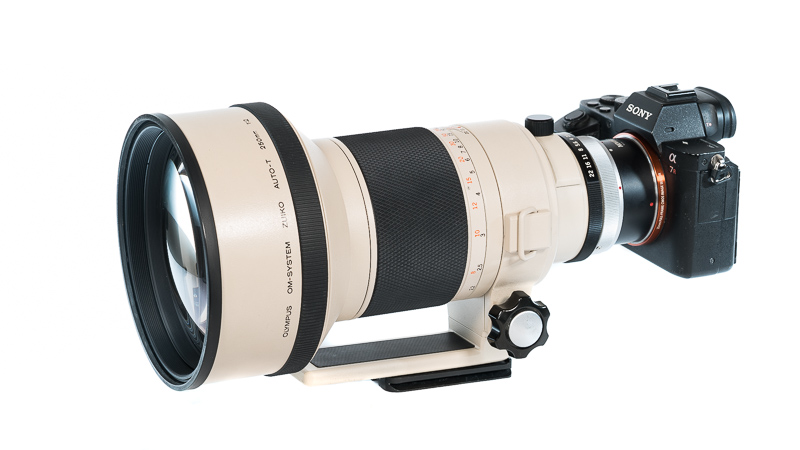
The Olympus OM 250mm 2.0 Zuiko Auto-T is one of those legendary lenses. Only few have been made and there has never been something similar again. So I was very excited to get the chance to have a look at one.
Samples


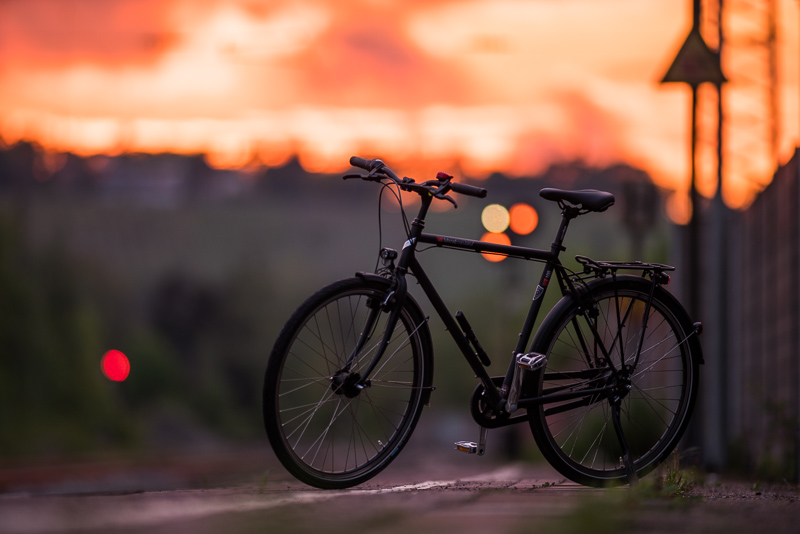
Disclosure
This lens was purchased by a reader who had it sent to me to check if everything is working properly and – if that is the case – to also write an in depth review on this rare lens.
Unfortunately this lens shows some deficiencies so I had to advise the owner to return the lens. Therefore this can only be a small hands on article.
Specifications / Version History
In the mid 1980’s Olympus really wanted to rival Canon and Nikon in the professional sports photography segment, so they introduced a 180mm 2.0, this 250mm 2.0 and a 350mm 2.8 super tele lens.
All three are spectacular designs: floating elements, special glass ED elements, lightweight construction, best in class minimum focus distance and high optical performance.
I didn’t manage to find out how many of these have been produced yet, but the 350mm 2.8 seems to be the easiest to get, the other two are a lot harder to come by. Nevertheless, this OM 2/250 has the following specifications:
-
- Diameter: 142 mm
- Field of view: 10° (diagonally)
- Length: 255 mm
- Weight: 3900g + adapter
- Filter Diameter: 46 mm (rear slot in)
- Number of Aperture Blades: 9 (rounded)
- Elements/Groups: 12/9
- Close Focusing Distance: 2.2 m
- Maximum Magnification: 1:7.3 (measured)
- Mount: Olympus OM
Your best bet getting one is on ebay.com (affiliate link). But these are really rare. Prices can vary between 5000$/€ up to 8000$/€ or even more.
Build quality / Handling
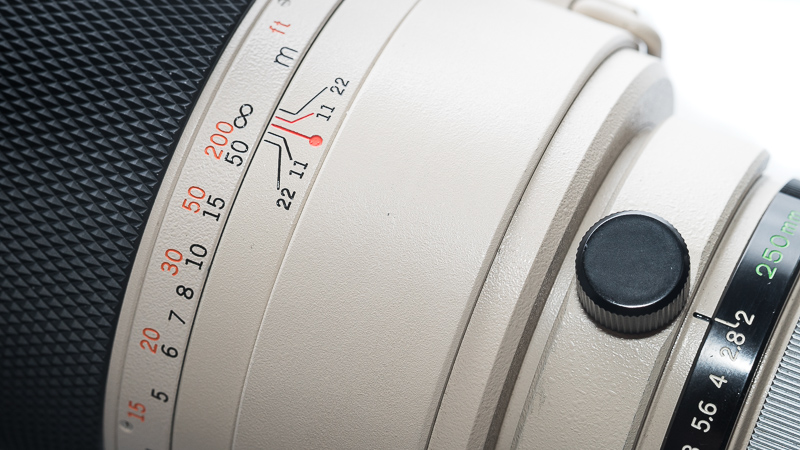
I have yet to come across a super tele lens with bad build quality. Everything except for the aperture ring is made from metal and feels very solid. The focus ring feels also very nice and offers even resistance. It takes ~160° from infinity to the minimum focus distance (2.2m).
The aperture ring has full-stop click stops and turns roughly 60° from f/2.0 to f/22.
The lens features 46mm slot in filters. Good luck finding the polarizer for this lens…
The Olympus 2/250 offers a retractable hood, I quite like these as they are easy to use and don’t take up additional space in the bag. The tripod collar is non detachable.
This lens feature a very complex internal focusing mechanism with lens groups changing their positions relative to each other, so the flange focal distance has a high influence on image quality. Therefore I recommend using the Novoflex OM-E adapter (affiliate link), as these adapters are tightly manufactured to give the correct flange focal distance.
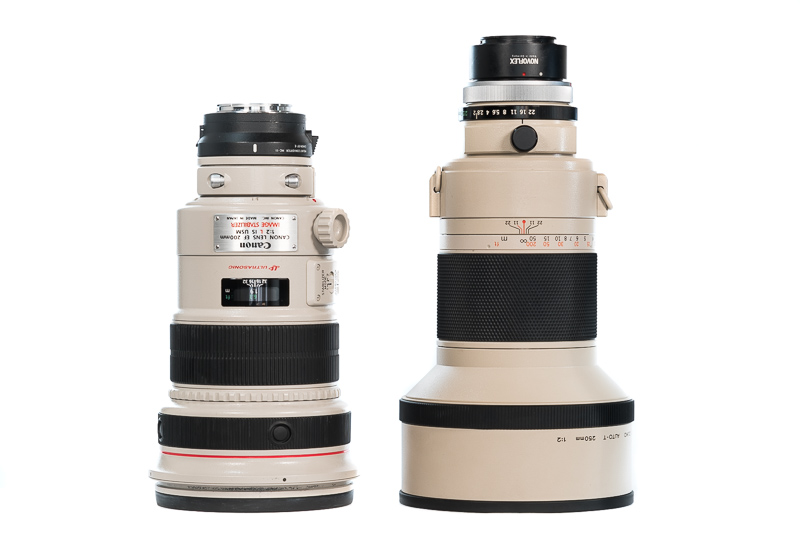
The Olympus lens is really massive and even makes the Canon EF 200mm 2.0 L IS look like a compact, reasonably sized lens.
Vignetting
light falloff
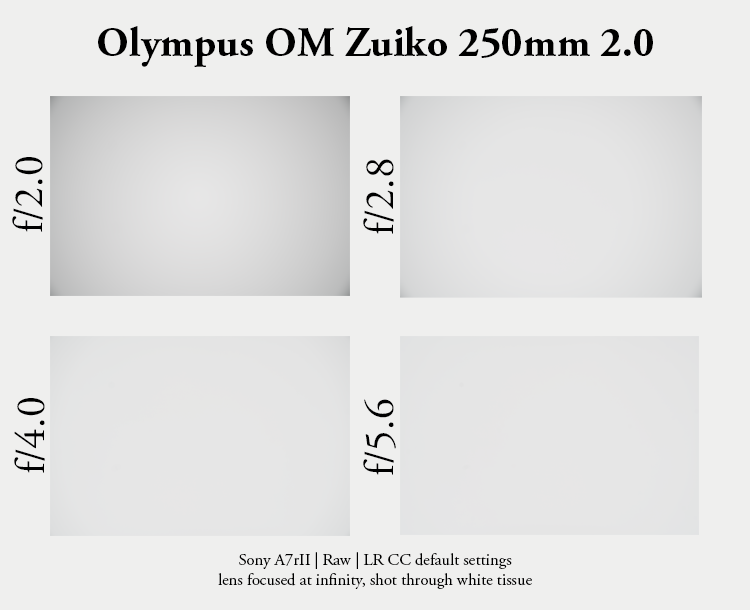
Wide open there is vignetting of roughly 1.9 EV, stopped down to f/2.8 this improves to 1.2 EV, stopped down to f/4.0 it is negligible with 0.5 EV and further improves to less than 0.2 EV at f/8.0. There is no Lightroom profile available for this lens.
mechanical vignetting
In the center of the frame almost every lens will render a perfect circle, but only lenses with very low mechanical vignetting will keep this shape in the corners.
So in the following comparison we move from the center (left) to the extreme corner (right) and see how the shape of the light circle changes.

You can see how similar lenses compare in my Best lenses for Brenizer/Bokehpanorama article.
Sharpness
As written before there was something wrong with this sample of the lens. Not only was decentering visible but the center showed subpar sharpness and contrast with lots of spherical aberration.
One of the corners on the other hand showed amazing performance, worthy of a super tele lens.
Therefore I cannot judge sharpness based on this sample at all.
Bokeh
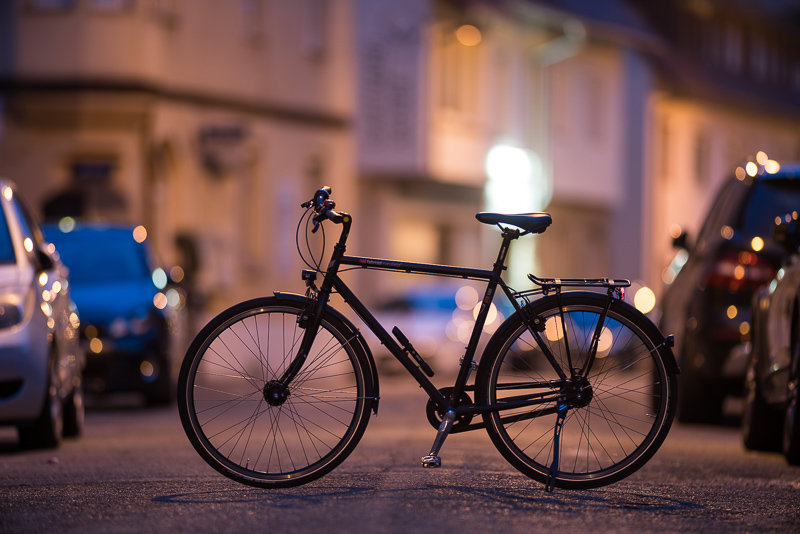
Its out of this world bokeh rendering is probably the main reason to get this lens today. It is the shortest lens with such a high blur potential.
And while it is already amazing when taking single shots (see above), where it really shines are brenizer/bokehpanoramas:
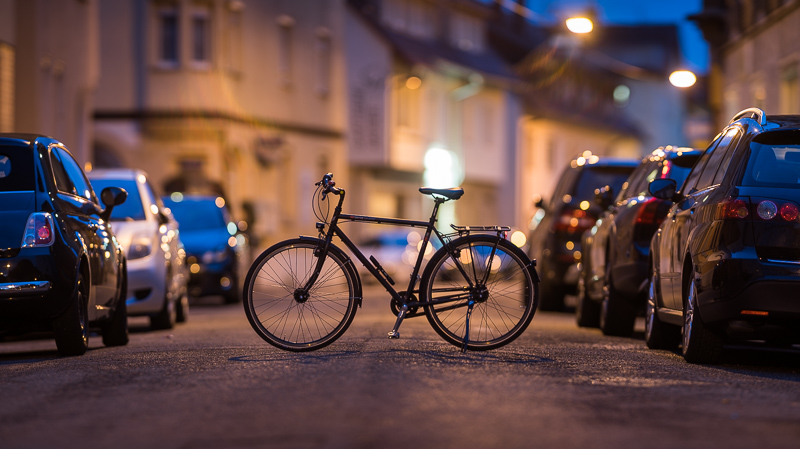
If you buy this lens to use it for portraiture the bokeh surely won’t disappoint, but the working distance might. Already for half body you need to be far away from the model and at the distance that is necessary for full body portraits communication will become quite the problem.
First impressions
It really is a shame the optics of this lens are not in better condition, who knows if I will ever get a chance to review one again?
While I can’t and won’t comment on sharpness the bokeh rendering is simply spectacular. A 25% longer focal length at the same maximum aperture compared to the 200mm f/2.0 lenses makes a more than notable difference.
But handling wise the 3.9 kg also make a notable difference compared to e.g. the 2.5 kg (without hood) of the Canon EF 200mm 2.0 L IS. The latter one is significantly easier to use and handle and fits in way more of my bags and backpacks.
Even being a faulty sample it was still interesting to have a closer look at this legendary lens. A forgotten, shining part of Olympus’ history.
PS: if you happen to own one – or in case you want to buy one and make sure it is worth its money within the return period – don’t hesitate to get in contact.
Your best bet getting one is on ebay.com (affiliate link). But these are really rare. Prices can vary between 5000$/€ up to 8000$/€ or even more.
Samples

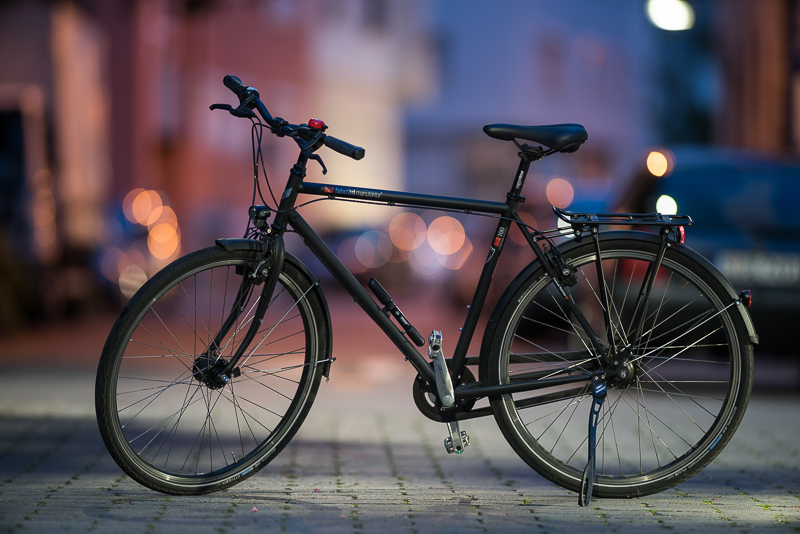
Further Reading
- Sony FE lenses: Our comprehensive and independent guide
- Sony FE lenses: Our guide to portrait lenses from 85 to 135mm
- Review: Canon EF 200mm 1.8 L
- Review: Sony FE 85mm 1.4 GM
Support Us
Did you find this article useful or just liked reading it? Treat us to a coffee!
![]()
![]()
![]() via Paypal
via Paypal
This site contains affiliate links. If you make a purchase using any of the links marked as affiliate links, I may receive a small commission at no additional cost to you. This helps support the creation of future content.
Latest posts by BastianK (see all)
- Review: SLRmagic 50mm 0.95 Hyperprime LM - July 5, 2025
- Full Resolution Pictures getting fixed - July 4, 2025
- Analogue Adventures Part 42: A wedding with Eastman Double-X 200 - July 2, 2025
Do the lenses work with 4/3?
You can mount it via adapter on m4/3, yes.
Lens will act like a 500mm f/4.0 on full frame then.
No AF of course.
You wouldn’t have happened to check the date code on the lens mount, did you?
I’ve been tracking manufacturing dates for various Olympus lenses for about 10 years now. I have date codes for this lens that range from 1984 to 1989, but nothing after that. I’m guessing that there were several short production runs, but that no more were made after (maybe) the early 90’s.
This lens has been modified with a Canon FD-mount by Canon Japan.
So no date code on the mount, sorry 🙂
Ah, it’s that one. I remember when it was listed on Ebay. Yeah, I was horrified that someone had done such a conversion.
For what it’s worth the FD-mount conversion appeared to have been well done. And when used on a mirrorless camera it doesn’t make a difference unless the conversion is botched.
Yes, very well done.
Yes, it looked well done.
My horror was merely on the principle of it: that such a rare lens would be changed in such a way–unless the original mount was also provided and it was reversible. But the Ebay listing didn’t suggest that was the case.
I have been following that particular lens.
It was listed (in Japanese) at a Tokyo camera store for 198,000 yen, roughly US$1,800. The Google translation made it seem to be in bad shape, mentioning “cut nails” (screws?) and a large mark on the front element where fungus had been “professionally cleaned.”
I offered them US$1,200 in English, and got no reply. I sent them a Google translated version, still no reply. I had a Japanese friend professionally translate my offer, using correct grammar and respectful language, and still no reply.
Then, I saw it on evilBay from an American seller for US$4,000.
I’ve seen at least one person claim there were under 600 of these lenses manufactured. It was reportedly tested by NASA, who said it was the best lens they had ever tested, bar none.
I agree that it is sad to see this lens butchered and mistreated. With the Canon FD register difference, it seems unlikely to ever restore this to a fully functioning OM mount.
I have since “settled” for a wonderful 350/2.8, which, with a Metabones Speedbooster Ultra, comes in at 250/2. But yea, it’s not the same. 🙂
Hi Mike,
Are you still tracking lens serial numbers? I have a 250mm f2 – TNE4 serial number 101098
Hope this is useful.
Kind regards
I have one of these 250mm f2.0 lenses that I aquired in about 2010. The serial number is 101153. The code on the lens mount is “TND4”. I think that that means April of 1984.
What did you think about the Fotodiox pro adapters vs. Novoflex? Not as tightly manufactured? Do you have experience with those?
Fotodiox are not so great. The cheap non-pro ones are not better than other cheap ones and some of the expensive pro ones are vastly overpriced.
We have an article discussing various adapters.
that’s beautiful bokeh. Would love to try this on my GFX50R xd
I had a similar issue – very strong spherical aberration and low contrast, and very high CA – with a 350/2.8. Glad I came across your article…
Rendering is off the charts. That’s the best I’ve seen at these focal lengths.
Ohhh…I think I got a lens from the same camera store ( ebay ?). Got my 250mm f2 on friday, horror with shipping. I´m no professional tester, but I have to say that my copy seems to be in a better condition ( although there are 3 mini scratches. about 1mm, in the rear element , often a bigger problem as a scratch in the front element ). I´m a pixel peeper at 100%, but it seems to have absolutely no effect for the image quality. Also the focussing is bit stiff.
This is definetely a real jewel, for me it looks like it is as sharp as my Pentax A* 200mm Macro,perhaps a bit sharper, the bokeh is the best I´ve ever seen.
Looks like your decentered lens is on ebay again, and the description of the dealer is still not honest.
For me, a dream came true, but now I have to make my training exercises, a 4kg lens is…..a bit too heavy for an old man like me, at least after an hour.
Ah, what I found out is, that there is a possibility to use a Pentax 128mm PF filter with this lens ( also fits the 350mm
2,8. Don`t have one, but I stumbled upon a picture of a 350mm 2.8 with that filter. Now I need one, but they are very hard to find.
Looks like my lens is from 1990 ( December ), maybe one of the last ones…
There was one on evilBay BIN for $200. I offered him $150, and he declined. It sat there for several months, and I again offered $150, and he accepted.
The problem with this “protection” filter is that the Olympus leather cap no longer fits properly. I drape it over for protection, but the zippers no longer zip.
Anyone know of a 128mm centre-pinch lens cap? 🙂
Still shooting with this behemoth of a lens? It’s great to hear you find the IQ holds up to the rumors. You’re comparing it to my current favorite lens for image quality in the Pentax 200m A* macro. I’ve been fortunate to own 2 of these lenses over the years, and the IQ blows me away every time I nail focus. If you’re ever considering selling the 250mm please reach out. I almost bought one from a German fellow at the beginning of covid but finances were a bit uncertain at the time. Of course now that I’m ready to make a purchase, they don’t seem to surface! Cheers and enjoy the lens in good health!
It’s on ebay for sale – 6.900 EUR. Can’t buy it 🙁
But it’s fun to see the pics.
https://www.ebay.de/itm/Olympus-Zuiko-250-mm-f-2-Objektiv-in-TOP-Zustand-/143499896542
Is this the decentered one described in the article
Hi Bastian,
I have a 250/2 I just purchased I will be able to lend for in depth testing. Would like to see if it truly is the best lens for Brenizer.
Feel free to PM
Cheers,
Max
interesting article. older one, i know, but ho knows: i own this lens, but it was stolen on dec.23rd,1993 in hamburg, germany. on an concert at the music club FABRIK. it has serial no. 101133. its without the case which is still here in my office. it had a huge sticker with the name of newspaper i was working for and some individual marks on lenses outside. it must be somewhere around. if somebody finds it… (later bought a second copy that i sold for my nikon af-s 2.8/300 when switching from olympus om 4 to nikon f5. this second ciopy’s serial number is 101130. hope new owner has same fun i had with that second lens.)